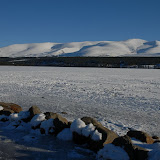The last February holiday I had in the Cairngorms was about 25 years ago and despite lugging skis all the way up from Bristol on the overnight train I and my companions spent our time walking in the mountains since the high winds had blown away most of the snow. My recollection of that trip was that it was clear and sunny and also bitterly cold - our real challenge was how to chop up the frozen logs so that it was possible to get them inside to thaw out.
This time round we again started the trip with almost implausibly blue skies but with almost no wind - and temperatures falling overnight to -15C, which was more than enough to freeze solid anything left in the car. Apples survive freezing and thawing much better than bananas - although deep-frozen bananas would appear to be an ideal healthy dessert. At least we didn’t have the challenge of log chopping - the Grant Arms Hotel in Grantown-on-Spey provides very effective oil-fired central heating.
During the first part of the week we visited Loch Morlich (where I once went canoeing, was solid enough to walk on) and Lochs Garten and Mallachie in Abernethy Forest (again both more suited to winter than water sports). We also did woodland walks around both Nethy Bridge and Grantown. All of these walks were in glorious sunshine with lots of beautifully crisp snow underfoot. We also took advantage of the clear sunny weather to go up Findhorn Bay and to briefly visit Culbin Sands. The most spectacular scenery was on the road north from Grantown and the A939 towards Tomintoul (often described as the first road to shut when the snow comes).
Around mid-week the weather changed pretty much completely - temperatures jumped to just below zero, the cloudless skies filled in and the snow started falling and just kept going - during the first snow-day we were able to keep moving around and visited both Anagach Woods and got at least as far as the bird feeders at Loch an Eilean if not to the Loch itself. By the morning of the second snow-day there was about 30 cm of snow on the car and on pretty much everything in/around the Cairngorms - and although we had another walk through part of Anagach Woods and looked at the Spey it wasn’t possible to do much more than that - and certainly very few of the cars in front of the hotel moved far.
After snowing for about 48 hours continuously (dumping a total of about 50 cm on the town - and well over 2 metres on the ski slopes, sufficient to bury the ski train) it did eventually relent allowing us (and several other folks in the hotel) to decide that it was time to try and head south. At this point the A9 was closed in both north and south directions, and the various hill roads out of Grantown to the north and east (the A939 had indeed shut first) certainly weren’t passable in anything other than a high clearance 4x4. The escape route - once we’d been helped out of our own personal snowdrift - was to head west, going down the A9 to Kingussie then across to Fort William on the west coast. This isn’t the most obvious route south from the Cairngorms - but was open and very dramatic in places particularly through Glen Coe and over Rannoch Moor. A 10 or 12 point stag standing in open snow-covered ground near road beside the Glen Coe ski area was particularly spectacular - shame there wasn’t any way to stop and take pictures.
As we got further south the snow mostly stopped - and by the time we made it to Edinburgh it had become messy persistent sleet.
In an effort to prolong my trip a little longer I went slowly through the snows south of Edinburgh, before spending a fantastic few hours at the WWT Reserve at Caerlaverock on the Solway Firth watching huge numbers of whooper swans and barnacle geese. The swans spend the winter in Scotland and head north to Iceland for the summer. The geese follow a similar itinerary but go to Svalbard in the summer – hopefully I’ll get to see them again later in the year.
 |
| Cairngorms February 2010 |
Types of Snow – the Inuit are suppose to have names for lots of types of snow – how many have the Scots got?
 |
| Snow |
1. We stayed at the Grant Arms Hotel - and the Bird Watching and Wildlife Club there provide lots of really useful information about what’s around and where - and encourages residents to log what they’ve seen too.
2. Our bird list for the 4 days in the Cairngorms got to 31 species – I was particularly pleased to see Crested Tits in Abernethy Forest.
3. Next time I go to the Cairngorms in winter I’m going to turn up in a 4x4.
No comments:
Post a Comment